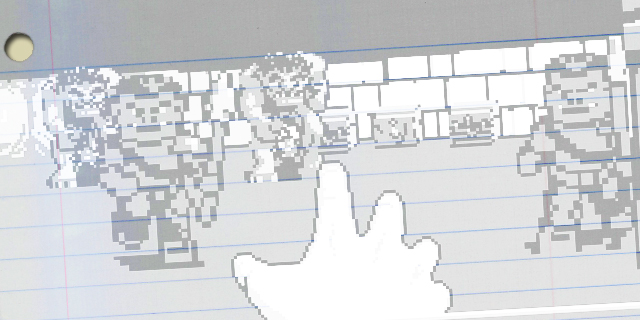
Genre 101 is a new series that looks at the past and present of a game genre to find lessons about what defines it. Each installment, Graham Russell brings in an expert “guest lecturer” to discuss significant and representative releases and topics. We start with the first-person shooter, and guest lecturer Andrew Passafiume.
Labyrinthine beginnings
 Andrew Passafiume: Very few people talk about (or are aware of) what is considered by many to be the first “first-person shooter.” Catacomb 3-D, developed by id Software, technically isn’t a shooter in the traditional sense (you use magic instead of guns), yet it is the game that established the id formula and eventually led the company down the path to create the shooters we are more familiar with. While many people consider Wolfenstein 3D as the shooter that started it all, they often overlook Catacomb and how it essentially moved the industry towards the future of first-person shooters.
Andrew Passafiume: Very few people talk about (or are aware of) what is considered by many to be the first “first-person shooter.” Catacomb 3-D, developed by id Software, technically isn’t a shooter in the traditional sense (you use magic instead of guns), yet it is the game that established the id formula and eventually led the company down the path to create the shooters we are more familiar with. While many people consider Wolfenstein 3D as the shooter that started it all, they often overlook Catacomb and how it essentially moved the industry towards the future of first-person shooters.
 Graham Russell: It’s natural, given the popularity of the D&D-style PC RPG at the time and its use of first-person perspectives, that the idea of moving around these areas in real-time would be linked so closely with this dark fantasy theme. With any first attempt in a genre, there are inevitably things the developers think will work, but get lost as the genre evolves. What did Catacomb 3-D have that didn’t end up as part of the core FPS formula?
Graham Russell: It’s natural, given the popularity of the D&D-style PC RPG at the time and its use of first-person perspectives, that the idea of moving around these areas in real-time would be linked so closely with this dark fantasy theme. With any first attempt in a genre, there are inevitably things the developers think will work, but get lost as the genre evolves. What did Catacomb 3-D have that didn’t end up as part of the core FPS formula?
 It is basically the rare example of a shooter that is heavily fantasy-inspired and uses “magic” instead of bullets. Some games followed its lead, such as Heretic and Hexen, but few actually stuck around, and they were viewed as simple Doom clones with fantasy elements by many. We still see the occasional fantasy elements in shooters (the Plasmids from BioShock come to mind immediately), but it’s certainly not as popular as, well, guns.
It is basically the rare example of a shooter that is heavily fantasy-inspired and uses “magic” instead of bullets. Some games followed its lead, such as Heretic and Hexen, but few actually stuck around, and they were viewed as simple Doom clones with fantasy elements by many. We still see the occasional fantasy elements in shooters (the Plasmids from BioShock come to mind immediately), but it’s certainly not as popular as, well, guns.
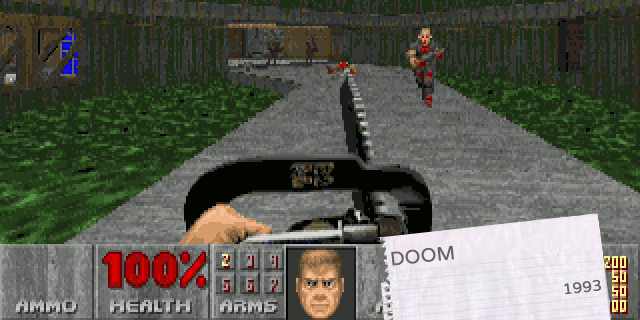
Of Doom and domination
 You can’t talk about first-person shooters without talking about Doom. It wasn’t the first, but it was, without a doubt, the game that made shooters cool. It borrowed elements from previous id games such as Wolfenstein 3D and made them work in a brand new setting, with level design that was chock-full of secrets to discover and plenty of enemies to mow down.
You can’t talk about first-person shooters without talking about Doom. It wasn’t the first, but it was, without a doubt, the game that made shooters cool. It borrowed elements from previous id games such as Wolfenstein 3D and made them work in a brand new setting, with level design that was chock-full of secrets to discover and plenty of enemies to mow down.
 It says a lot that Doom, this dated, relatively-simplistic experience, has stuck around in the way it has. These days, “can it run Doom?” is kind of a punchline, but throughout the ‘90s, it was much more important. In that way, it really created the archetypical tech-pushing role of the genre that continues to this day, most prominently with games like Crysis. Why do you think it’s taken this spot? Is the genre easiest to show impressive visuals with, or is it simply that the games sell well enough to have the budget to push the envelope?
It says a lot that Doom, this dated, relatively-simplistic experience, has stuck around in the way it has. These days, “can it run Doom?” is kind of a punchline, but throughout the ‘90s, it was much more important. In that way, it really created the archetypical tech-pushing role of the genre that continues to this day, most prominently with games like Crysis. Why do you think it’s taken this spot? Is the genre easiest to show impressive visuals with, or is it simply that the games sell well enough to have the budget to push the envelope?
 This is a tough question to answer, because it almost feels like a game that came around at the right time and was successful because of that and not because of anything it did. Not to dismiss Doom’s merits, but at the time of its release, shooters weren’t exactly the most popular genre around. I think it’s mostly that, at the time, there was nothing quite like it visually. I think id was the one company that was able to take the FPS formula and really push it to the limit of the technology available. It made something that you had to stop and stare at when you saw it, because there really was nothing else like it on the market, even with its similarities to id’s other games.
This is a tough question to answer, because it almost feels like a game that came around at the right time and was successful because of that and not because of anything it did. Not to dismiss Doom’s merits, but at the time of its release, shooters weren’t exactly the most popular genre around. I think it’s mostly that, at the time, there was nothing quite like it visually. I think id was the one company that was able to take the FPS formula and really push it to the limit of the technology available. It made something that you had to stop and stare at when you saw it, because there really was nothing else like it on the market, even with its similarities to id’s other games.

Consoles’ golden child
 Doom was the game that really moved things in the right direction, but GoldenEye 007, Rare’s James Bond title based on the film of the same name, sparked a different trend: the console FPS. While there were shooters on consoles prior to GoldenEye’s release, this was the first console-exclusive that really brought people together. The campaign was solid and demonstrated how shooters can work on a console, but it was in the game’s competitive multiplayer where it really made its mark.
Doom was the game that really moved things in the right direction, but GoldenEye 007, Rare’s James Bond title based on the film of the same name, sparked a different trend: the console FPS. While there were shooters on consoles prior to GoldenEye’s release, this was the first console-exclusive that really brought people together. The campaign was solid and demonstrated how shooters can work on a console, but it was in the game’s competitive multiplayer where it really made its mark.
 You’re right; for the early days of the genre, having a respectable console entry was just unheard of. After GoldenEye, it was common: Halo. TimeSplitters. Call of Duty. What was new about GoldenEye’s multiplayer formula that made it really break through?
You’re right; for the early days of the genre, having a respectable console entry was just unheard of. After GoldenEye, it was common: Halo. TimeSplitters. Call of Duty. What was new about GoldenEye’s multiplayer formula that made it really break through?
 I think it’s simple: you gather three friends around your TV, plug in some controllers and you’re basically ready to go. Having a shooter that you were able to play with friends locally made a world of difference, and it’s a formula that carried the genre forward on consoles for the longest time until Xbox Live took off in a big way. The variety of weapons, game modes and maps certainly helped as well, making it a game that had seemingly-endless replay value as long as you had people to play it with.
I think it’s simple: you gather three friends around your TV, plug in some controllers and you’re basically ready to go. Having a shooter that you were able to play with friends locally made a world of difference, and it’s a formula that carried the genre forward on consoles for the longest time until Xbox Live took off in a big way. The variety of weapons, game modes and maps certainly helped as well, making it a game that had seemingly-endless replay value as long as you had people to play it with.
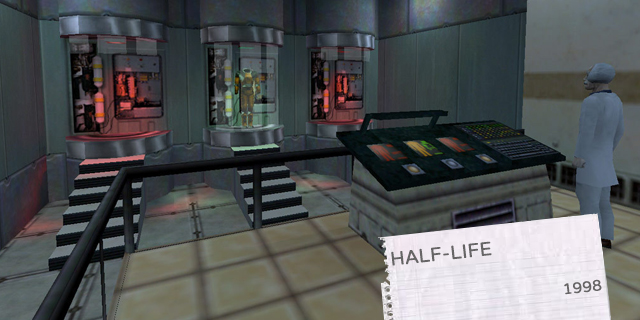
Tales worth telling
 At this time, first-person shooters weren’t about story so much as providing a fun campaign with plenty of enemies to shoot and a multiplayer component that would keep people coming back for more. Valve’s original masterpiece, Half-Life, changed that for the better. It created a shooter that wasn’t just about, well, shooting, with a rich atmosphere and a story that never took you out of the action. Half-Life 2 continued this evolutionary trend in 2004 with physics-based puzzles and an even more brilliantly designed campaign, but Half-Life was the game that both put Valve on the map and also created a different brand of shooter.
At this time, first-person shooters weren’t about story so much as providing a fun campaign with plenty of enemies to shoot and a multiplayer component that would keep people coming back for more. Valve’s original masterpiece, Half-Life, changed that for the better. It created a shooter that wasn’t just about, well, shooting, with a rich atmosphere and a story that never took you out of the action. Half-Life 2 continued this evolutionary trend in 2004 with physics-based puzzles and an even more brilliantly designed campaign, but Half-Life was the game that both put Valve on the map and also created a different brand of shooter.
 The first-person experience really does lend itself to powerful storytelling; after all, you’re there. You’re in it. Half-Life was just the beginning, obviously, but without it, would we have BioShock Infinite? Would we have Spec Ops: The Line? Not likely.
The first-person experience really does lend itself to powerful storytelling; after all, you’re there. You’re in it. Half-Life was just the beginning, obviously, but without it, would we have BioShock Infinite? Would we have Spec Ops: The Line? Not likely.
 Exactly. It’s not easy to make a game with a story worth remembering, and maybe Half-Life’s story in particular is nothing special compared to the titles you’ve mentioned, yet it sticks out because, at the time, you really had nothing else like it. Just wandering around Black Mesa at the beginning before you even get to the shooting part of the FPS is something that I will always remember.
Exactly. It’s not easy to make a game with a story worth remembering, and maybe Half-Life’s story in particular is nothing special compared to the titles you’ve mentioned, yet it sticks out because, at the time, you really had nothing else like it. Just wandering around Black Mesa at the beginning before you even get to the shooting part of the FPS is something that I will always remember.
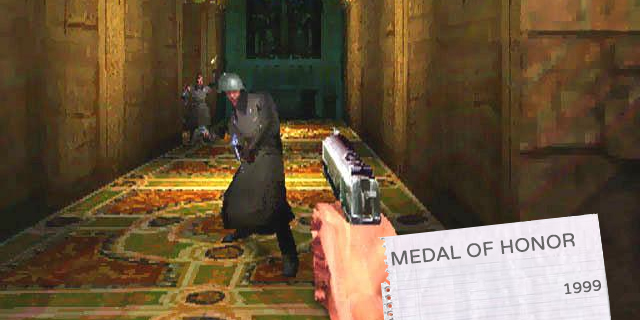
History lessons
 While GoldenEye was making waves on the N64, there were a multitude of different shooters on Sony’s original PlayStation, but very few of them actually stuck around. The original Medal of Honor, however, is considered by many as the shooter that popularized the WWII genre and inspired countless sequels, spinoffs and even clones. Without Medal of Honor, we wouldn’t have Call of Duty (which we’ll touch on more later) or even Battlefield (with the original, 1942, focusing on providing a multiplayer experience unlike any other).
While GoldenEye was making waves on the N64, there were a multitude of different shooters on Sony’s original PlayStation, but very few of them actually stuck around. The original Medal of Honor, however, is considered by many as the shooter that popularized the WWII genre and inspired countless sequels, spinoffs and even clones. Without Medal of Honor, we wouldn’t have Call of Duty (which we’ll touch on more later) or even Battlefield (with the original, 1942, focusing on providing a multiplayer experience unlike any other).
 It’s true: to understand first-person shooters, you need to understand World War II. It has the elements a game needs! It offers realism and accuracy, while staying modern enough to have usable weaponry. It has the scale and significance that smaller conflicts don’t, and plenty of real-world stories to base games on. More than that, though, it has clearly-defined sides and the closest modern-era combat comes to a good-versus-evil struggle.
It’s true: to understand first-person shooters, you need to understand World War II. It has the elements a game needs! It offers realism and accuracy, while staying modern enough to have usable weaponry. It has the scale and significance that smaller conflicts don’t, and plenty of real-world stories to base games on. More than that, though, it has clearly-defined sides and the closest modern-era combat comes to a good-versus-evil struggle.
 It’s crazy to think how fast it came and went too. When you had Medal of Honor, Call of Duty and Battlefield all competing for the same market at the same time, it seemed inevitable, but it happened faster than I thought it would. Of course, now we have that same issue with modern military shooters, but I think the popularity of that outside of Call of Duty and Battlefield is basically nonexistent at this point. Maybe someday the WWII shooter will become popular again? Probably not.
It’s crazy to think how fast it came and went too. When you had Medal of Honor, Call of Duty and Battlefield all competing for the same market at the same time, it seemed inevitable, but it happened faster than I thought it would. Of course, now we have that same issue with modern military shooters, but I think the popularity of that outside of Call of Duty and Battlefield is basically nonexistent at this point. Maybe someday the WWII shooter will become popular again? Probably not.
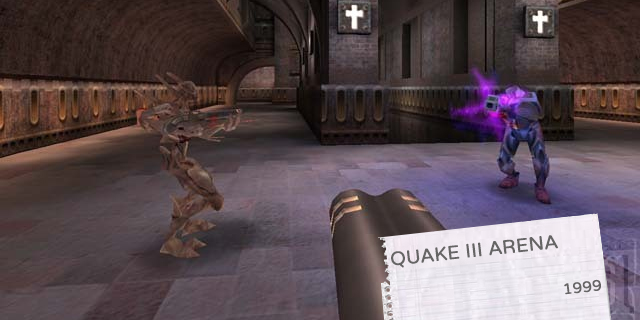
Competitive combat
 First-person shooters with multiplayer components were all over the place, but few were games built entirely around the idea of being multiplayer-only. Two such games emerged in 1999: id’s Quake III Arena and Epic Games’ Unreal Tournament. They weren’t entirely dissimilar games, but they both made other developers in the genre realize you didn’t need a lengthy single-player campaign to make a game that people would talk about and remember for years to come. While Quake III had the pedigree, Unreal Tournament was from a developer without too much experience (which later led to the success of the Unreal Engine). These aren’t the first multiplayer-only shooters (with Valve’s Counter-Strike making a splash for entirely different reasons), but they are considered two of the best the genre had to offer.
First-person shooters with multiplayer components were all over the place, but few were games built entirely around the idea of being multiplayer-only. Two such games emerged in 1999: id’s Quake III Arena and Epic Games’ Unreal Tournament. They weren’t entirely dissimilar games, but they both made other developers in the genre realize you didn’t need a lengthy single-player campaign to make a game that people would talk about and remember for years to come. While Quake III had the pedigree, Unreal Tournament was from a developer without too much experience (which later led to the success of the Unreal Engine). These aren’t the first multiplayer-only shooters (with Valve’s Counter-Strike making a splash for entirely different reasons), but they are considered two of the best the genre had to offer.
 Solo and multiplayer FPSs may run on similar engines, but the two are largely disparate experiences with differing appeal. It’s almost like comparing disc golf and ultimate; there are shared mechanics and skills, but they’re not the same experience. Sports are an apt comparison, because these games’ focus on the competitive experience really birthed an eSports movement.
Solo and multiplayer FPSs may run on similar engines, but the two are largely disparate experiences with differing appeal. It’s almost like comparing disc golf and ultimate; there are shared mechanics and skills, but they’re not the same experience. Sports are an apt comparison, because these games’ focus on the competitive experience really birthed an eSports movement.
 These games aren’t the easiest to get into, but once they hook you, you’ll stay hooked for a long time, which is why the competitive shooter scene has remained pretty popular. The games are different, but there will always be those games for those people. And despite growing up playing Unreal Tournament and Quake, multiplayer isn’t something I can stick with because of my lack of time to devote to it, which is why I focus on the single-player above anything else.
These games aren’t the easiest to get into, but once they hook you, you’ll stay hooked for a long time, which is why the competitive shooter scene has remained pretty popular. The games are different, but there will always be those games for those people. And despite growing up playing Unreal Tournament and Quake, multiplayer isn’t something I can stick with because of my lack of time to devote to it, which is why I focus on the single-player above anything else.

Maintaining the excitement
 The original Halo did something that no game since GoldenEye was able to do: make the console FPS cool again. It introduced some pretty widely-used elements, such as the recharging shield (which would eventually turn into recharging health) and being able to carry only two weapons at a time, things that you either love or hate depending on your preferences. The most important innovation, however, is how the AI of your enemy was handled. Each encounter, no matter what, would be different. You would have to change your strategies on the fly to deal with the unpredictable Covenant forces. This, combined with some incredibly detailed open environments, made Halo a force to be reckoned with.
The original Halo did something that no game since GoldenEye was able to do: make the console FPS cool again. It introduced some pretty widely-used elements, such as the recharging shield (which would eventually turn into recharging health) and being able to carry only two weapons at a time, things that you either love or hate depending on your preferences. The most important innovation, however, is how the AI of your enemy was handled. Each encounter, no matter what, would be different. You would have to change your strategies on the fly to deal with the unpredictable Covenant forces. This, combined with some incredibly detailed open environments, made Halo a force to be reckoned with.
 It’s hard to talk about Halo without mentioning its “30 seconds of fun” mantra. The design was centered around being this string of engaging moments, changing things up from vehicles to corridors and back again before you get bored. It was geared to the short-attention-span generation, sure, but it’s not necessarily bad for others either. One thing’s for sure: games that followed certainly emulated the formula.
It’s hard to talk about Halo without mentioning its “30 seconds of fun” mantra. The design was centered around being this string of engaging moments, changing things up from vehicles to corridors and back again before you get bored. It was geared to the short-attention-span generation, sure, but it’s not necessarily bad for others either. One thing’s for sure: games that followed certainly emulated the formula.
 It worked remarkably well and, for better or worse, has inspired a generation of people who both play and make games, as you said. It’s a formula that could have failed, but without Halo, chances are this entire feature (and the trajectory of the genre) would have turned out very differently.
It worked remarkably well and, for better or worse, has inspired a generation of people who both play and make games, as you said. It’s a formula that could have failed, but without Halo, chances are this entire feature (and the trajectory of the genre) would have turned out very differently.
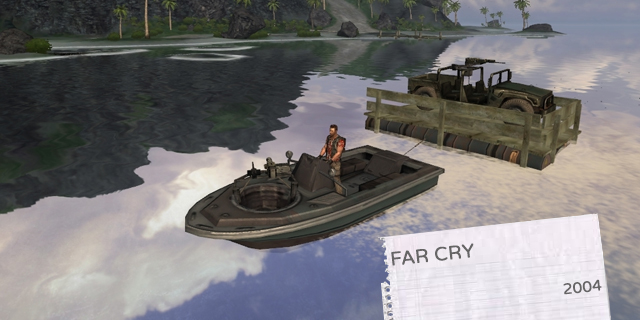
Broadening the scope
 The original Far Cry isn’t a game you often hear mentioned when discussing influential shooters, but I consider it one of the best examples of a genre-defining title. While Epic Games’ original shooter, Unreal, gave players something more than just narrow corridors and a handful of optional objectives by being the first FPS to introduce a more open environment (something that Halo expanded upon in certain levels), Far Cry was the game that popularized the open-world shooter and the first example of how to get it right. Giving the player multiple ways to approach different objectives was great, allowing them to try something other than walking in a straight line, but it also introduced a fairly large environment for you to explore.
The original Far Cry isn’t a game you often hear mentioned when discussing influential shooters, but I consider it one of the best examples of a genre-defining title. While Epic Games’ original shooter, Unreal, gave players something more than just narrow corridors and a handful of optional objectives by being the first FPS to introduce a more open environment (something that Halo expanded upon in certain levels), Far Cry was the game that popularized the open-world shooter and the first example of how to get it right. Giving the player multiple ways to approach different objectives was great, allowing them to try something other than walking in a straight line, but it also introduced a fairly large environment for you to explore.
 This has been building in the genre, so much that we have games like Borderlands and, well, Far Cry 3, with organically-occurring encounters as you wander around. It also starts to overlap with shooter-RPGs like recent Fallout entries. It proves that first-person and shooting are simply camera styles and combat mechanics, and what you choose to implement them in doesn’t have to be an endless corridor with occasional cover.
This has been building in the genre, so much that we have games like Borderlands and, well, Far Cry 3, with organically-occurring encounters as you wander around. It also starts to overlap with shooter-RPGs like recent Fallout entries. It proves that first-person and shooting are simply camera styles and combat mechanics, and what you choose to implement them in doesn’t have to be an endless corridor with occasional cover.
 Basically. Far Cry proved that open world can work in this genre just fine. With so many games out there focused on delivering a tight, linear experience, it’s so refreshing when we do get a game like Far Cry 3 so focused on delivering the opposite of that in almost every regard. If anything, Far Cry established a trend toward making sure the genre has more variety.
Basically. Far Cry proved that open world can work in this genre just fine. With so many games out there focused on delivering a tight, linear experience, it’s so refreshing when we do get a game like Far Cry 3 so focused on delivering the opposite of that in almost every regard. If anything, Far Cry established a trend toward making sure the genre has more variety.
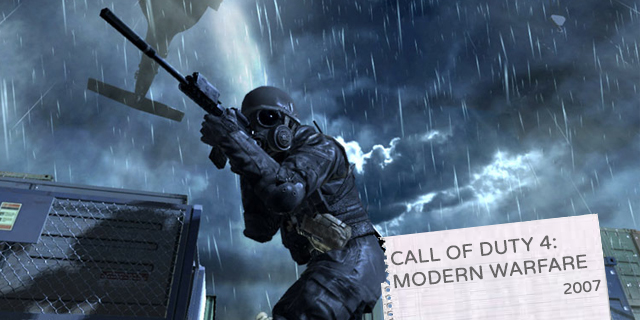
Modernizing the genre
 What can I say about Call of Duty 4 that hasn’t been said? When you think of “modern military shooters,” the Call of Duty franchise is what probably comes to mind immediately, and the original Modern Warfare is the game that started it all. It had an excellent campaign that was linear, sure, but also a spectacle in many ways. It introduced exciting multiplayer components, including the perk system and earning XP to gain new levels and equipment, something that has been seen in so many shooters since. If there is any game that has defined a generation of shooters, or even a generation of games in general, it is this one.
What can I say about Call of Duty 4 that hasn’t been said? When you think of “modern military shooters,” the Call of Duty franchise is what probably comes to mind immediately, and the original Modern Warfare is the game that started it all. It had an excellent campaign that was linear, sure, but also a spectacle in many ways. It introduced exciting multiplayer components, including the perk system and earning XP to gain new levels and equipment, something that has been seen in so many shooters since. If there is any game that has defined a generation of shooters, or even a generation of games in general, it is this one.
 While most genres have that “breakout” game that gets imitated in all aspects (including bad ones), the FPS has had a few. Certainly whatever was in Modern Warfare has made its way into anything that’s trying to make money, but the multiplayer XP thing is probably its most defining innovation. Without it, would we be heading the way we are with titles like Titanfall and Destiny?
While most genres have that “breakout” game that gets imitated in all aspects (including bad ones), the FPS has had a few. Certainly whatever was in Modern Warfare has made its way into anything that’s trying to make money, but the multiplayer XP thing is probably its most defining innovation. Without it, would we be heading the way we are with titles like Titanfall and Destiny?
 Or just about every shooter on the market, honestly. Even Halo 4 has Call of Duty-style perks and leveling. Think about how crazy that is. Call of Duty probably wouldn’t be as big on consoles if not for Halo, and now Halo is borrowing from the series it essentially inspired in some regards (at least on consoles). What a weird thing.
Or just about every shooter on the market, honestly. Even Halo 4 has Call of Duty-style perks and leveling. Think about how crazy that is. Call of Duty probably wouldn’t be as big on consoles if not for Halo, and now Halo is borrowing from the series it essentially inspired in some regards (at least on consoles). What a weird thing.
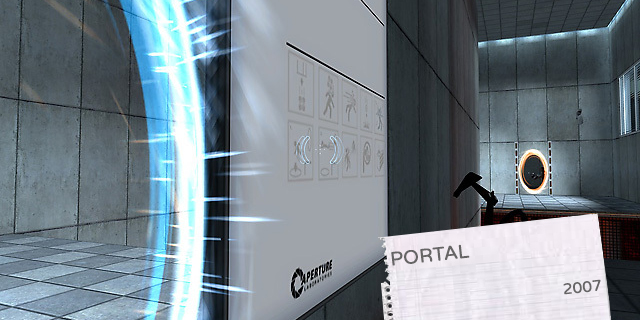
Applying new knowledge
 Not every first-person game is going to involve using guns to kill your enemies, and that’s what separates Portal from just about every other game on this list. This only barely qualifies as an FPS (you’re just shooting portals instead of bullets), yet I feel it belongs in this group. While you don’t see an overflow of puzzle-based first-person games in the same way you saw an exuberant amount of WWII shooters after Medal of Honor or military shooters after Modern Warfare, it started a trend that led developers down the path of exploring new ways to tell stories and create puzzle games.
Not every first-person game is going to involve using guns to kill your enemies, and that’s what separates Portal from just about every other game on this list. This only barely qualifies as an FPS (you’re just shooting portals instead of bullets), yet I feel it belongs in this group. While you don’t see an overflow of puzzle-based first-person games in the same way you saw an exuberant amount of WWII shooters after Medal of Honor or military shooters after Modern Warfare, it started a trend that led developers down the path of exploring new ways to tell stories and create puzzle games.
 You know, there were at least a few titles in the subgenre spawned by Portal, most notably Quantum Conundrum, Antichamber and Magrunner. Anyway, it’s also important to point out the mark it has left on more traditional FPS titles. Not all the games have been great, but many have implemented physics-based weaponry and traversal puzzles.
You know, there were at least a few titles in the subgenre spawned by Portal, most notably Quantum Conundrum, Antichamber and Magrunner. Anyway, it’s also important to point out the mark it has left on more traditional FPS titles. Not all the games have been great, but many have implemented physics-based weaponry and traversal puzzles.
 Oh yeah, that inspiration is clear, it’s just not as big of an inspiration for games as some of these other titles. It doesn’t mean it’s less important; it just has reflected less on the genre as a whole than other Valve games. Having said that, like with Half-Life (and Half-Life 2), it teaches you all about telling a story without relying on cutscenes. Let the player live in that world. Valve is especially good at that sort of thing; they just replace the innards to make it a wholly different experience. You can see that with Portal 2, as it reflects that Valve style even more than the original. Plus, physics-based first-person puzzle games are conceptually exciting, and we’re still only scratching the surface of that potential.
Oh yeah, that inspiration is clear, it’s just not as big of an inspiration for games as some of these other titles. It doesn’t mean it’s less important; it just has reflected less on the genre as a whole than other Valve games. Having said that, like with Half-Life (and Half-Life 2), it teaches you all about telling a story without relying on cutscenes. Let the player live in that world. Valve is especially good at that sort of thing; they just replace the innards to make it a wholly different experience. You can see that with Portal 2, as it reflects that Valve style even more than the original. Plus, physics-based first-person puzzle games are conceptually exciting, and we’re still only scratching the surface of that potential.
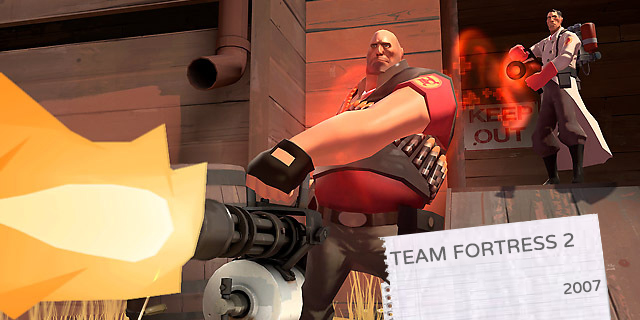
The new economics
 Team Fortress 2 never started as a free-to-play game, yet it feels like the ultimate example of one. It also wasn’t the first game to try F2P, but it became the shining example of how to handle the model excellently. You can play TF2 and not spend a cent and still have an excellent time. There are things to buy, of course, but they are unnecessary items that won’t drastically change your experience. Since the success of TF2, the F2P model has become a huge business venture for many companies, including those you may have never considered attempting such a thing. It hasn’t revolutionized the genre as much as it brought forth a new way to create an entertaining game and business model that doesn’t undermine everything that makes a compelling FPS experience to begin with.
Team Fortress 2 never started as a free-to-play game, yet it feels like the ultimate example of one. It also wasn’t the first game to try F2P, but it became the shining example of how to handle the model excellently. You can play TF2 and not spend a cent and still have an excellent time. There are things to buy, of course, but they are unnecessary items that won’t drastically change your experience. Since the success of TF2, the F2P model has become a huge business venture for many companies, including those you may have never considered attempting such a thing. It hasn’t revolutionized the genre as much as it brought forth a new way to create an entertaining game and business model that doesn’t undermine everything that makes a compelling FPS experience to begin with.
 Do you think that any other games can find success using Team Fortress 2’s formula? With the unique situation of having the popularity already and being supported by the Steam infrastructure and its role in promoting its adoption, it had a lot going for it. The next one on the horizon is the strangely-themed Garden Warfare, with the hefty backing of EA and the super-popular Plants vs. Zombies IP. Will that succeed because of how it’s emulating TF2?
Do you think that any other games can find success using Team Fortress 2’s formula? With the unique situation of having the popularity already and being supported by the Steam infrastructure and its role in promoting its adoption, it had a lot going for it. The next one on the horizon is the strangely-themed Garden Warfare, with the hefty backing of EA and the super-popular Plants vs. Zombies IP. Will that succeed because of how it’s emulating TF2?
 It’s hard to say. I think that game will succeed because of the Plants vs. Zombies brand more than anything. Team Fortress 2’s model of class-based multiplayer isn’t completely new to the genre, yet it feels like the first game that brought people’s attention to it and inspired other, similar games to borrow ideas from that design. That, and F2P feels like it never completely took off until TF2. That was either remarkable timing on Valve’s part, or it just got completely lucky.
It’s hard to say. I think that game will succeed because of the Plants vs. Zombies brand more than anything. Team Fortress 2’s model of class-based multiplayer isn’t completely new to the genre, yet it feels like the first game that brought people’s attention to it and inspired other, similar games to borrow ideas from that design. That, and F2P feels like it never completely took off until TF2. That was either remarkable timing on Valve’s part, or it just got completely lucky.
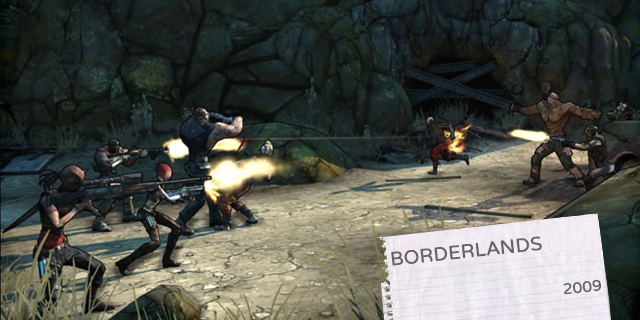
Progress report
 While you could argue that Call of Duty 4 was the first to make “RPG elements” in shooters popular, that system only feels like an RPG in the most basic sense. Borderlands, on the other hand, is as much of an RPG as it is a shooter. Not only that, it seems to have inspired a pretty recent trend of loot-based, RPG-heavy shooter experiences, some of which haven’t seen the light of day quite yet. When Bungie, the team behind Halo, is developing a title that draws comparisons to Borderlands, you know you have a game that is both influential and teaches just how to incorporate other genre standbys while still maintaining what makes a shooter tick in the first place.
While you could argue that Call of Duty 4 was the first to make “RPG elements” in shooters popular, that system only feels like an RPG in the most basic sense. Borderlands, on the other hand, is as much of an RPG as it is a shooter. Not only that, it seems to have inspired a pretty recent trend of loot-based, RPG-heavy shooter experiences, some of which haven’t seen the light of day quite yet. When Bungie, the team behind Halo, is developing a title that draws comparisons to Borderlands, you know you have a game that is both influential and teaches just how to incorporate other genre standbys while still maintaining what makes a shooter tick in the first place.
 Loot is this Skinner box mechanic that can make any formula addicting, but does it really make it better? Can a game tell a compelling story when you’re just scavenging for parts? It can be funny, sure, as Borderlands shows, but can it have a powerful narrative like BioShock?
Loot is this Skinner box mechanic that can make any formula addicting, but does it really make it better? Can a game tell a compelling story when you’re just scavenging for parts? It can be funny, sure, as Borderlands shows, but can it have a powerful narrative like BioShock?
 BioShock Infinite has loot to gather and, to me, it never detracts from the things that make that game amazing. I could see how it could distract someone from the bigger picture when it’s a story-heavy experience like BioShock, but most games following Borderlands’ lead seem less focused on that stuff and more focused on making sure you always have something to collect as a reward for whatever thing you just did. With BioShock, it’s a background element, but Borderlands is very upfront about making sure you are always collecting loot or at least thinking about collecting loot. I think other games might not be as in-your-face about that stuff, but it’s clear this is a trend that won’t be going away anytime soon.
BioShock Infinite has loot to gather and, to me, it never detracts from the things that make that game amazing. I could see how it could distract someone from the bigger picture when it’s a story-heavy experience like BioShock, but most games following Borderlands’ lead seem less focused on that stuff and more focused on making sure you always have something to collect as a reward for whatever thing you just did. With BioShock, it’s a background element, but Borderlands is very upfront about making sure you are always collecting loot or at least thinking about collecting loot. I think other games might not be as in-your-face about that stuff, but it’s clear this is a trend that won’t be going away anytime soon.



















